
The Mail waxes lyrical about its favourite subject
What fun the media has been having with light bulbs lately, peddling claims that they are extremely dangerous due to the mercury they contain and that they could cause skin cancer. With an eye recently sobered by new year abstinence, let's take a closer look.
The furore has been sparked by two incidents, the first being a call from the Environment Agency for better consumer information on the packaging of energy-efficient bulbs. They're concerned that people don't know they contain mercury and that they need to be disposed of in a responsible manner, which is fair enough. As the Royal Society for Chemistry (RSC) notes, even though mercury has always been present in fluorescent lighting (including the strip lighting that has been in wide-spread use for yonks), it just hasn't been leapt on as a health issue before now.
The Environment Agency is, quite rightly, focusing on getting the bulbs recycled properly, but trust the Daily Mail to get the wrong end of the stick. "Energy-saving light bulbs are so dangerous that everyone must leave the room for at least 15 minutes if one falls to the floor and breaks," it screeched, neglecting to mention that CFLs contain only a few milligrams of mercury unlike bathroom thermometers with a few whole grams of the stuff. Would I find an article in the Mail's dim and distant past warning of the dangers of putting in your mouth a thin glass tube filled with toxic metal? Possibly, but probably not.
Even the government says that the mercury in CFLs doesn't pose
any real danger. "No amount of mercury is good for you," says the
Department for Environment, Food and Rural Affairs (Defra), "but the
very small amount contained in a single modern CFL is unlikely to cause any
harm, even if the lamp should be broken." (Via the RSC, although I can't
find the original text It's actually from an interview conducted by an RSC journalist.)
And of course, CFLs will reduce the overall amount of mercury released into the environment - far more is released when burning fossil fuels, particularly coal, to power incandescents than is contained in a CFL.
The media also picked up on the second spark, a press release from Spectrum - a coalition of organisations focusing on skin disorders - and the British Association of Dermatologists (BAD). This wasn't surprising as it contained the word 'cancer' and we all know how the Mail loves to froth at the mouth on the subject. The newspaper claimed that the 'new' bulbs (they're not new; they've been around for over 30 years) "can give you skin cancer", but from where I'm sitting the organisations seemed more concerned about making sure people who suffer from photosensitive conditions won't be left in the dark. Again, that's fair enough and if there was a general ban on incandescent bulbs, they could still be made available on prescription.
However, Dr Colin Holden from BAD did say: "Photosensitive eruptions range from disabling eczema-like reactions, to light sensitivities that can lead to skin cancer." On that matter, I refer you to Professor John Hawk of the British Skin Foundation who, when asked on the Today programme if CFLs could cause cancer, said: "I think that is going to far, you'd have to be exposed to them for unbelievable amounts of time. There have been reports in the past suggesting that was possible but they haven't really been substantiated and I think that's unlikely to happen."
Did I say there were two sparks? Actually, there were three. The Migraine Action Association said it was swamped with over 200 calls and emails from members who said the flickering from CFLs caused migraines. It also said that while there are up to six million people in the UK who suffer from migraines, "the bulbs do not necessarily affect every sufferer." Again the Mail got its knickers in a twist over this, but the Telegraph ran a slightly more reserved report.
I've picked on the Daily Mail - partly because it invites this kind of criticism, but mainly because its fun - but these scare stories travelled round the world. Even novelist Lionel Shriver inadvertently jumped on the bandwagon, stating she will be hording incandescents simply because she doesn't like CFLs and saying rather pompusly: "I figure that my family of two already does its bit."
While there's no denying that a small number of people do experience adverse reactions to fluorescent lights and the organisations mentioned above have genuine concerns, the media's reaction has been a knee-jerk in response to a perceived ban on incandescent bulbs which doesn't in fact exist, at least not yet. As things stand, it's a purely voluntary agreement and although most major retailers have signed up, we're still working on making the phase-out mandatory. By the way, you can still email the government asking for exactly that.
It's just strange that these stories should all surface within a few days of each other in something of a dead period for news. I'm not a conspiracy theorist but it is a curious coincidence.

